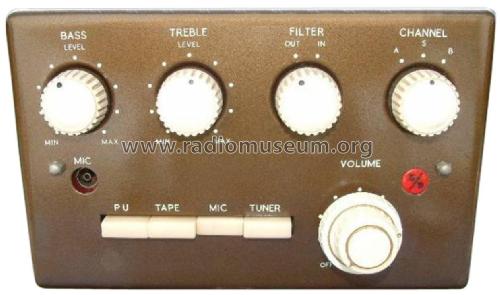RD Junior Control Unit
Rogers, Catford (see also Rogers Birmingham)
- Pays
- Royaume Uni
- Fabricant / Marque
- Rogers, Catford (see also Rogers Birmingham)
- Année
- 1952–1954 ?
- Catégorie
- Amplificateur BF ou mélangeur BF
- Radiomuseum.org ID
- 357235
- No. de tubes
- 1
- Lampes / Tubes
- 12AX7
- Principe général
- Amplification audio
- Gammes d'ondes
- - sans
- Tension / type courant
- Alimentation externe ou alimentation principale
- Haut-parleur
- - Pour casque ou amplificateur BF
- Matière
- Boitier métallique
- De Radiomuseum.org
- Modèle: RD Junior Control Unit - Rogers, Catford see also
- Forme
- Chassis (pour intégration dans meuble)
- Remarques
-
The RD Junior Control Unit introduced by Rogers in 1952, was designed to complement their Junior De-Luxe and Baby De-Luxe power amplifiers. This initial model featured a straightforward design centered around a single ECC83 preamplifier, equipped with four input sockets and a switched low-pass filter.
Design and Features
- The Control Unit was characterized by its simplicity and functionality. It included:
- Four Input Sockets: These allowed for basic audio source connections, catering to the needs of early high-fidelity systems.
- Switched Low-Pass Filter: This feature helped manage the frequency response, ensuring that only lower frequencies were amplified, which was essential for maintaining audio quality.
Performance
Although the Control Unit was basic compared to later iterations, it laid the groundwork for more advanced features. The unit's design emphasized reliability and ease of use, making it a suitable choice for audiophiles looking to enhance their listening experience without the complexities of more sophisticated equipment.
Legacy
The RD Junior Control Unit set the stage for subsequent models, such as the Mk II (2), which introduced additional features like variable filters and multiple input options. This evolution reflected the growing demands of audio technology during the 1950s, positioning Rogers as a key player in the high-fidelity market.
This rare Control Unit remains a notable example of early audio engineering, appreciated for its straightforward approach to sound amplification.
- Auteur
- Modèle crée par Gary Cowans. Voir les propositions de modification pour les contributeurs supplémentaires.
- D'autres Modèles
-
Vous pourrez trouver sous ce lien 39 modèles d'appareils, 39 avec des images et 6 avec des schémas.
Tous les appareils de Rogers, Catford (see also Rogers Birmingham)
